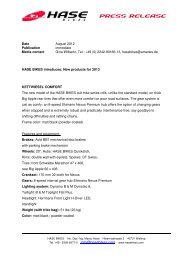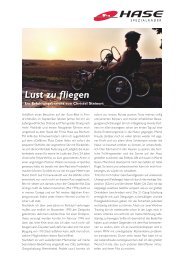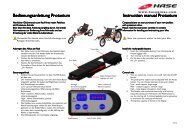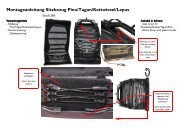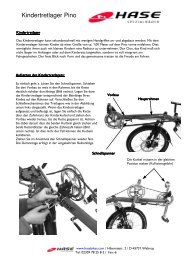Trets Mode d'emploi, version 9-09 F-ENG - Hase Bikes
Trets Mode d'emploi, version 9-09 F-ENG - Hase Bikes
Trets Mode d'emploi, version 9-09 F-ENG - Hase Bikes
Create successful ePaper yourself
Turn your PDF publications into a flip-book with our unique Google optimized e-Paper software.
TRETS<br />
Contrôle et réglage du dérailleur<br />
Reportez-vous à la notice jointe par le fabricant du dérailleur.<br />
Le dérailleur a été réglé minutieusement en usine. Il est néanmoins<br />
possible qu‘à l‘usage le câble se détende, affectant la<br />
précision du dérailleur.<br />
. Si la chaîne ne passe pas facilement sur un pignon plus<br />
grand, tendez le câble en tournant la butée de gaine<br />
réglable au niveau du dérailleur ( ) ou de la poignée de<br />
commande d’à peu près un tour complet dans le sens<br />
antihoraire. Si la chaîne passe difficilement sur un pignon<br />
plus petit, tournez la butée dans le sens des aiguilles d‘une<br />
montre.<br />
2. En tournant les pédales roue arrière droite levée, passez<br />
les vitesses dans les deux sens. Si la chaîne passe facilement<br />
d’un pignon à l’autre, le dérailleur est correctement<br />
réglé. Il se peut que plusieurs essais soient nécessaires.<br />
Pour éviter que la chaîne ne saute aux deux extrémités de la<br />
cassette, deux butées limitent sa course. En utilisation normale,<br />
il n‘y a pas lieu d‘en modifier le réglage. Si un réglage devait<br />
toutefois être nécessaire, p. ex. si le dérailleur ou la patte de<br />
dérailleur étaient tordus, procédez comme suit :<br />
. Tout en faisant tourner les pédales, positionnez la chaîne<br />
sur le plus petit pignon. Vérifiez maintenant si les galets du<br />
dérailleur sont alignés avec le plus petit pignon quand vous<br />
regardez de derrière.<br />
2. Dans le cas contraire, tournez la vis cruciforme (marquée<br />
« H ») jusqu‘à ce que les galets soient parfaitement alignés<br />
avec le pignon.<br />
3. Tout en faisant tourner les pédales, faites monter doucement<br />
la chaîne sur le plus grand pignon.<br />
4. Vérifiez en regardant de derrière si les galets du dérailleur<br />
sont maintenant alignés avec le grand pignon.<br />
5. Dans le cas contraire, tournez la vis cruciforme (marquée<br />
« L ») jusqu‘à ce que les galets soient parfaitement alignés<br />
avec le pignon.<br />
Entretien et réparation<br />
Maintenance and repair<br />
Checking and adjusting the derailleur<br />
Please note the information provided in the enclosed manual<br />
from the gear system manufacturer. The derailleur has been<br />
carefully adjusted at the factory. Over time, however, the<br />
gear cables tend to stretch, and the derailleur may no longer<br />
function with the same precision.<br />
. If the chain seems reluctant to move onto the next larger<br />
sprocket (next lower gear) when shifting, then tighten the<br />
bowden cable by turning the barrel adjuster on the derailleur<br />
( ) or grip shifter one full turn counterclockwise. If<br />
the chain seems reluctant to move onto the next smaller<br />
sprocket (next higher gear), then turn the barrel adjuster<br />
clockwise.<br />
2. Shift up and down while turning the crank with the right<br />
rear wheel lifted. If the chain switches easily between<br />
sprockets in both directions, the derailleur is properly adjusted.<br />
It may be necessary to check and readjust several<br />
times before the proper setting is found.<br />
The limit stops prevent the chain from falling off of the two<br />
outer sprockets. These stops generally do not require readjustment<br />
with normal tricycle use. If a readjustment nevertheless<br />
becomes necessary, for example, because the derailleur<br />
or derailleur hanger is bent, proceed as follows:<br />
. While turning the crank, shift the chain to the smallest<br />
sprocket. Now check whether the guide pulley of the derailleur<br />
is in line with the smallest sprocket when looking<br />
from the back.<br />
2. If this is not the case, turn the Phillips screw marked with<br />
an “H” until the guide pulley of the derailleur is in exact<br />
alignment with the sprocket.<br />
3. While turning the crank, carefully shift the chain to the<br />
largest sprocket.<br />
4. Check whether the guide pulley of the derailleur is now in<br />
line with the largest sprocket when looking from the back.<br />
5. If this is not the case, turn the Phillips screw marked with<br />
an “L” until the guide pulley of the derailleur is in exact<br />
alignment with the sprocket.<br />
<strong>Trets</strong> 9/<strong>09</strong>-F-<strong>ENG</strong> 2





